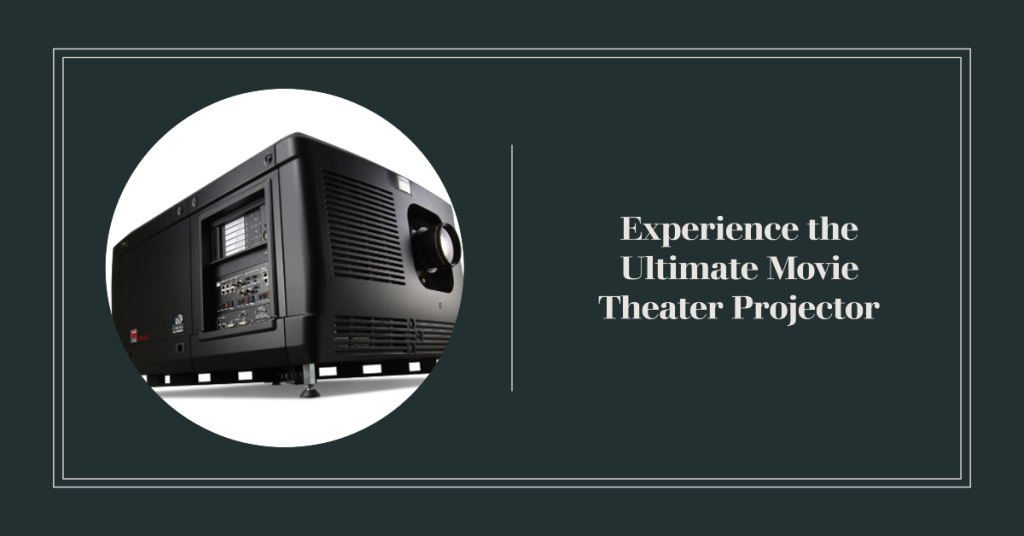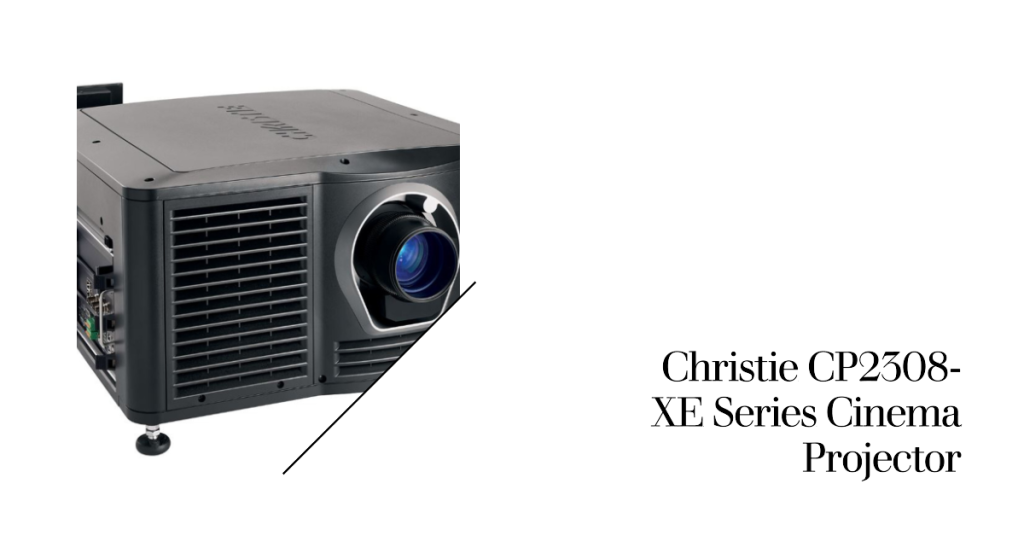Movie theaters utilize heavy-duty, state-of-the-art projectors to deliver the immersive cinematic experience audiences expect on the giant silver screen. But what specific models and technologies go into bringing major motion pictures to life in theaters?
This comprehensive guide will examine the critical components professional cinema projectors need, overview the leading theater projector manufacturers, compare DLP vs IMAX vs other technologies, and reveal the most common projectors found in movie theaters small and large. Let’s explore the cutting-edge projection systems powering the movie theater industry today!
Key Components of Movie Theater Projectors
While home theater projectors prioritize affordability, cinema projectors are all about unparalleled image quality and reliability. Here are the vital components theaters demand:
High Resolution
Digital projectors in theaters offer 2K, 4K, or even 8K resolution for ultra sharp images, with 4K becoming the standard.
Increased Brightness
With massive screens and darkened rooms, theaters utilize powerful xenon lamps projecting 10,000+ lumens for perfectly visible pictures.
Enhanced Contrast Ratios
Contrast ratios measuring 2,000:1 and above create inky blacks beside vibrant colors that make scenes pop.
Laser Light Sources
Lasers offer increased brightness, wider color range, lower operating costs, and decreased maintenance compared to traditional xenon lamps.
Solid State Cooling
Movie projectors require active cooling for their intense lamps. New sealed solid-state systems reduce noise and increase reliability.
Media Server Compatibility
Theater projectors connect to high-end media servers that store and deliver digital film files and playlists.
These core components enable cinema projectors to create flawless images across massive screens while running reliably 12+ hours daily. Next let’s look at the top projector brands used in movie theaters.
Leading Movie Theater Projector Manufacturers
The major Hollywood studios demand the most cutting-edge projection technology for premiering their blockbuster films. As a result, just two manufacturers dominate the global movie theater market:
Christie Digital
Founded in 1929, Christie creates advanced digital cinema projectors, high-tech displays, and cinema processing systems. Their Series 3 Mirage projectors with patented triple-stage TruLife electronics are the go-to for major theater chains.
Barco
Barco designs state-of-the-art projection displays for theaters worldwide. Their Series 4 portfolio offers 4K resolution, Rec. 2020 color space support, and Barco Alchemy signal processing for pristine movie playback.
These industry leaders account for over 80% of worldwide cinema projector market share. Both offer proprietary technologies built for theater performance and reliability. Beyond these giants, theaters may also use:
- Sony – Their 4K SXRD projectors blend high resolution with brightness and laser technology adopted by some large chains.
- NEC – Offers more affordable cinema projectors with laser phosphor and xenon lamps ideal for independent theaters.
Now that we’ve covered the major movie theater projector companies, how do the most common projection technologies like DLP and IMAX compare?
Movie Theater Projector Technology Comparison
Movie theaters may utilize Digital Light Processing (DLP), Liquid Crystal on Silicon (LCoS), or IMAX projection technologies in their auditoriums. Here is how they stack up:
| Technology | Pros | Cons |
|---|---|---|
| DLP | Fast pixel response for smooth motion | Screen door effect on edges, May show rainbow artifacts |
| LCoS | Superb color and tone accuracy, Crisp image with no artifacts, Wide viewing angles | Expensive initial costs, Heat management can be difficult |
| IMAX | Massive immersive displays, Incredible detail and resolution, Custom theaters with giant curved screens | Very expensive implementation, Limited content produced in IMAX, Fewer current installations |
DLP reigns as the most common digital projection technology used in cinemas today due to its bright images, fast refresh rates, and operational efficiency. It uses a digital micromirror device (DMD) with an array of microscopic mirrors to precisely reflect light through color wheels onto the screen.
LCoS (Liquid Crystal on Silicon) competes on ultimate visual quality but has struggled with wider adoption due to higher costs. But it remains an excellent choice for premium large format (PLF) auditoriums. It uses liquid crystals instead of mirrors to individually block or transmit light.
IMAX boasts unmatched levels of immersion thanks to its pioneering extra-large screens and 70mm film projection format. While IMAX theaters are costlier to implement, they provide an incredible cinematic experience that can’t be replicated at home.
Now that we’ve compared the advantages of each cinema technology, let’s look at the actual projector models commonly found in movie theaters today.
Most Common Movie Theater Projectors
Theaters worldwide depend on advanced projectors engineered to exacting specifications in order to deliver moviegoers the stunning visuals filmmakers intend. While high-end projectors from Christie, Barco, Sony, and NEC dominate, here are four of the most ubiquitous and trusted models found in cinemas small and large:
1. Christie CP4325-RGB RealLaser Cinema Projector

With 34,000 lumens brightness, 4K resolution and Christie’s CineLife+ electronics, the CP4325-RGB utilizes pure laser light sources for intensely vivid cinematic visuals up to 120fps ideal for PLF screens. Christie BrilliantColor technology and TruLife video processing ensure color accuracy throughout the long runtimes required.
Key Specs:
- Resolution: 4K (4096 x 2160)
- Brightness: 34,000 lumens
- Contrast: 3,000:1
- Light Source: Laser phosphor with Christie RealLaser
- Frame Rates: 96 or 120 fps
Use Cases: Premium large format (PLF) screens, giant screen implementations
2. Barco Series 4 DP4K-36BLP 4K Cinema Projector

Barco’s Series 4 DP4K-36BLP cinema projector delivers razor sharp 4K resolution through an efficient 36,000 lumen laser phosphor light source capable of High Frame Rates (HFR) exceeding 60 fps for 3D playback. It’s the first DLP Cinema projector with a native 4K chip which Barco calls ALPD technology. The Barco Alchemy media processor ensures pristine images and adaptive brightness control.
Key Specs:
- Resolution: 4K (4096 x 2160)
- Brightness: 36,000 lumens
- Contrast: 2,800:1
- Light Source: Laser phosphor
- Frame Rates: 60 fps (120 fps capable)
Use Cases: Mid-size to premium screens
3. Christie CP2308-XE Series Cinema Projector

A workhorse model found in cinemas worldwide, the Christie CP2308-XE utilizes a Xenon bulb to project 8000 lumens using Christie’s Solaria Series electronics platform. With a max image width of 27 feet, it’s designed for mid-sized theater screens delivering 2K resolution using DLP imaging chips from Texas Instruments.
Key Specs:
- Resolution: 2K (2048×1080)
- Brightness: 8,000 lumens
- Contrast: 1900:1
- Light Source: Xenon lamp (CDXL-20SD)
- Frame Rates: 48 fps
Use Cases: Mid-size theater screens; mainstream 2K projections
4. Sony SRX-R320 4K Projector

Sony’s SRX-R320 delivers bright 4K projections thanks to a 4,500W lamp matched with an efficient optical engine and Dynamic Lamp Control regulating brightness when possible. It uses Sony’s native 4K SXRD imaging technology with 4096 x 2160 4K resolution on its 3 SXRD chips. Integrated active 3D playback expands entertainment capabilities.
Key Specs:
- Resolution: 4K (4096 x 2160)
- Brightness: 18,000 lumens
- Contrast: 3000:1
- Light Source: 4.5kW high pressure mercury lamp
- Frame Rates: 120 fps
Use Cases: Mid-size premium screens; 4K and active 3D
While additional Barco, Christie, NEC, and Sony models are found worldwide, these four projectors represent the most ubiquitous and modern cinema projectors typically installed in movie theaters today to meet quality and reliability demands.
Final Considerations for Cinema Projector Procurement
Beyond technical specifications, theater owners must evaluate a few additional variables when selecting projectors:
Screen Size – Match projector brightness and supported resolutions to planned screen sizes in each auditorium, with 4K needed for screens exceeding 50ft.
3D Capable – Many theaters require active 3D support for premium showings which requires high frame rates exceeding 60 fps.
Costs – Projector price is just one component. Installation, maintenance, bulb/laser replacements, and electricity costs add up. Efficiency saves money long-term.
Future Proofing – With expected projector lifespans around 10 years, invest in 4K models compatible with upcoming innovations.
While home theaters prioritize affordability, movie theaters demand best-in-class performance, reliability, and longevity when investing in cinema projectors to deliver an unmatched viewing experience. Partnering with trusted brands like Christie, Barco, and Sony provides peace of mind.
Powering the Magic of the Movies
Movie theater projectors represent the pinnacle of projection technology – purpose built to smoothly deliver major motion pictures across giant screens while running constantly. State-of-the-art 4K models from Christie, Barco, Sony, and NEC utilizing advanced lasers, high frame rates, and robust processing reliably bring Hollywood blockbusters to life around the world.
This guide provided an inside look into the key components, leading manufacturers, competing technologies, and most trusted cinema projector models powering modern movie theaters to maintain the magic of the silver screen. While home theaters offer convenience, nothing rivals the cinematic experience of watching major feature films in the theater thanks to these engineering marvels expressly designed to project perfection.

